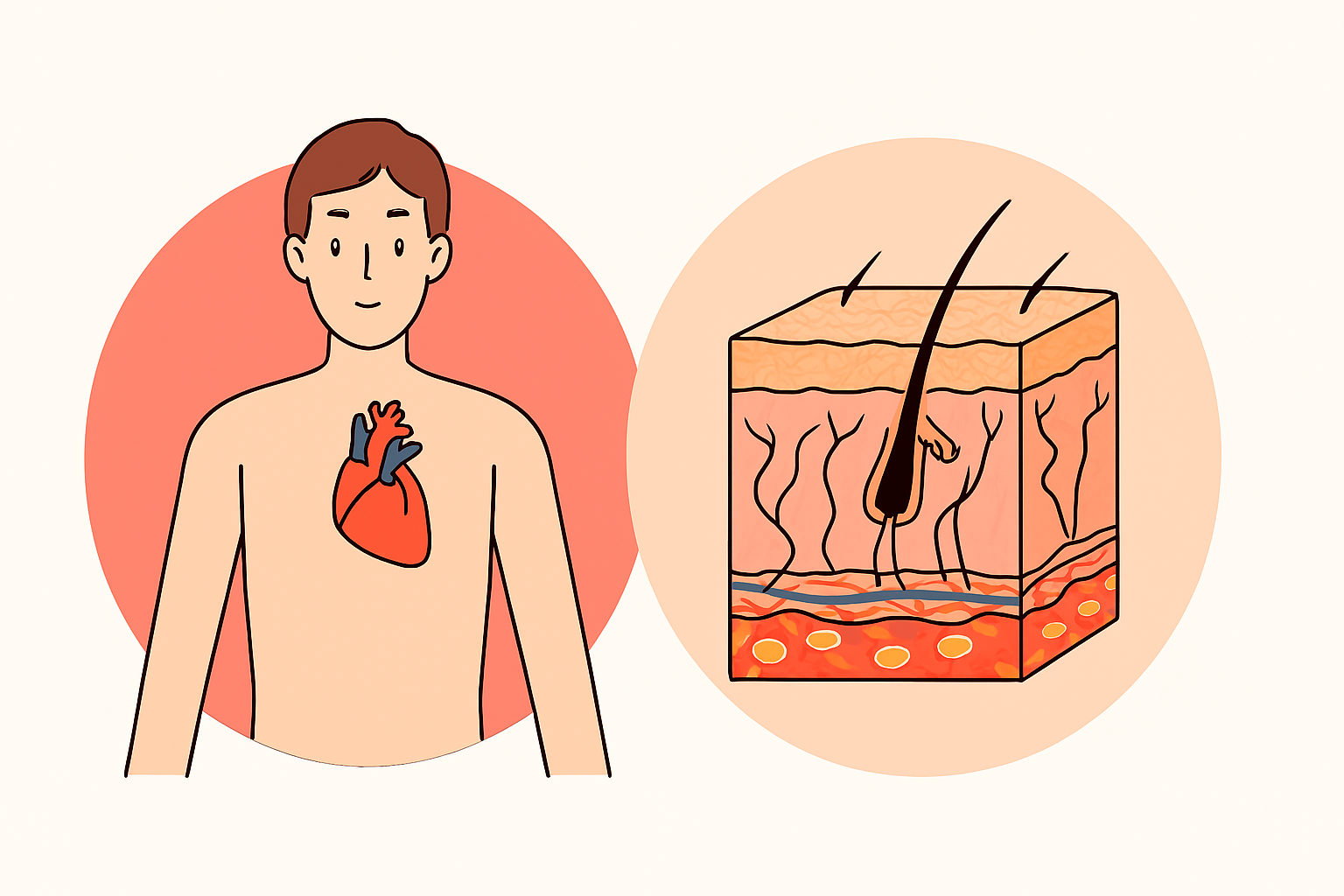Our body is a biological machine. It is composed of numerous organs that work together to maintain our life and health.
Among the many organs, a common question arises: what is the biggest organ in the human body?
Which is the Largest Organ of our body?
The Skin is the biggest organ of the human body. Covering the entire body, skin is not only a protective layer but a complex structure with multiple functions key to survival.
Skin- The Biggest Organ of the Body- How big is it?
An average adult carries around 20 to 22 square feet of skin. It accounts for approximately 16% of the person’s body weight.
What are the functions of the skin- The body’s Largest Organ!
Skin is one of the primary sense organs that can sense touch, heat, pressure, cold, pain and pleasure. Its other functions are-
- Skin prevents water loss
- It regulates body temperature
- It shields internal organs, bones and tissues from injuries, pathogens and harmful UV radiation.
- It contains millions of nerve endings that detect heat, cold, touch and pain.
- Skin acts as a first line of defense against infections
- When exposed to sunlight, it helps produce Vitamin D, which is essential for bone health.
- It protects the internal organs by avoiding the entry of pathogens
- Excretes excess of water, salts and other wastes in the form of sweat through the sweat pores
What are the Layers of the Skin?
- Epidermis
- Dermis
- Hypodermis
Skin- Largest Organ of the Body- Why is it considered an Organ?
An organ is a structure composed of different tissues that work together to perform a specific function. The skin fits this definition perfectly. It consists of multiple tissue types performing interconnected functions.
Skin is not only the largest organ in the body but also one of the most multifunctional organs.
Interstitium– Might be the Largest Internal Organ in the Human Body
According to a recent 2018 article, the interstitium may now be the largest organ. The findings suggest that the interstitium might be bigger than the skin.
What is Interstitium?
More than half of our body’s fluid is located in the cells. About a seventh of the body’s fluid is found in the lymph nodes, lymph vessels, heart and blood vessels. The rest of the fluid is called the interstitial fluid.
The interstitium is a series of fluid-filled spaces made of flexible connective tissue. This network of tissue is called a lattice or mesh. It was founded in –
- Below the skin’s surface
- In fascia
- In the lining of the lungs and digestive tract
- Lining of the urinary system
- Surrounding your arteries and veins
The interstitium is the body’s main source of lymph fluid. As per the research, it also protects tissue from the natural movement of the organs – Contraction of the GI tract when digesting the food.
However, more research is needed to understand its functions and overall size.
Largest Internal Organ of the Human Body
Liver – The Liver is the second-largest organ in the body. It weighs approximately 3 – 3.5 pounds and is the size of a football. It is located below the rib cage and lungs, in the upper right area of the abdomen. It is the body’s chemical factory. Its functions-
- Detoxify harmful substances from the blood.
- Produce bile, which aids in the digestion and absorption of fats.
- Stores glycogen, vitamins and minerals
- Synthesizes important proteins like clotting factors
- Regulates metabolism of carbohydrates, proteins and fats.
- Make proteins for blood plasma.
Lungs- Lungs are the largest organ inside the body by volume. They are a pair of spongy organs located on either side of the chest, responsible for breathing and oxygen exchange. They can hold up to 6 litres of air in total capacity. Their functions-
- Exchange oxygen and carbon dioxide during respiration.
- Help regulate blood pH.
- Filter small blood clots and air bubbles.
- Play a key role in the vocal sound production.
Brain – The human brain weighs about 3 pounds or 1.36 kilograms. It is about the same size as two clenched fists. It is your body’s control center.It is one of the most important organs, controlling every function of the body, from voluntary movement to involuntary processes like heartbeat and breathing. Its functions-
- Processes thoughts, memory and emotions
- Controls coordination, reflexes and movement
- Regulates hormone production through the pituitary gland
- Manages learning, problem-solving and decision-making.
Heart – After the lungs, the next largest internal organ is the heart. It is of the same size as two hands clasped together. Your heart is situated between the lungs, positioned slightly to the left. It works tirelessly from birth until death. It weighs around 250 to 350 grams. Its functions-
- Pumps oxygenated blood throughout the body.
- Removes carbon dioxide and waste products
- Maintains blood pressure and circulation.
Kidneys- Kidneys are the bean-shaped organs located on either side of the spine, just below the ribcage. They are smaller compared to the liver or lungs; their importance is undeniable. They weigh about 150 gms each. An average kidney is about 10 to 12 centimetres. Each kidney is roughly the size of a small fist. Their functions-
- Filter waste products from the blood
- Regulate water, salt and mineral balance.
- Produce hormones that regulate blood pressure and red blood cell production.
Intestines: While not the largest organ in our body, the intestines cover an enormous length. The small intestine length is around 20 feet, and the large intestine length is 5 feet. Their functions-
- Absorb nutrients from blood.
- Reabsorb water and electrolytes
- Eliminate waste
Final Thoughts
What is the human body’s biggest organ? Skin is the largest organ in the human body. One 2018 research states interstitium is the largest organ, still research is going on in this respect which makes skin as the largest body organ. Each organ plays a key role. Together they form the intricate system that keeps us alive, functioning and thriving.
FAQs
- What is the largest organ in the human body?
Skin is the largest organ in the human body. - Which is the largest internal organ in the human body?
The liver is the largest internal organ in the human body. - Are lungs bigger than the liver?
Yes, lungs are larger in volume compared to the liver. - Which organ controls the entire body?
The brain controls the entire body. - How can I keep my organs healthy?
With a healthy, balanced diet, regular exercise, hydration, avoiding smoking and excessive alcohol, one can keep their organs healthy.




